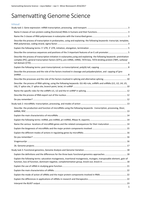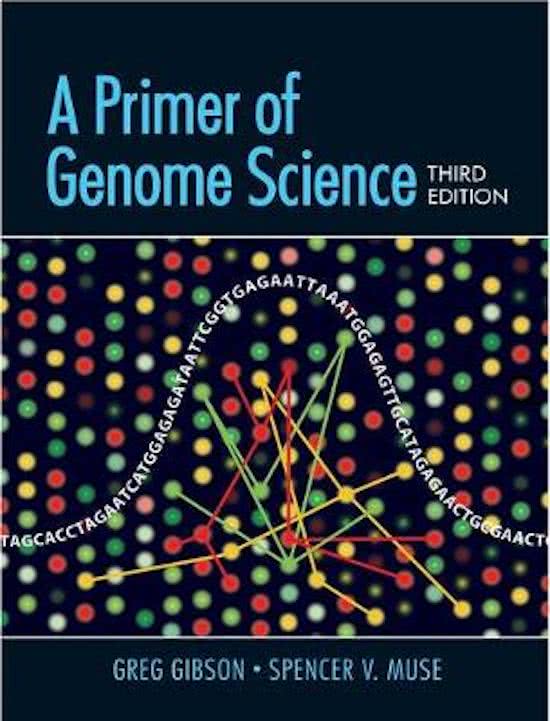Samenvatting Genome Science – Joyce Bakker – Jaar 3 - Minor Bioresearch 2016/2017
Samenvatting Genome Science
Inhoud
Study task 1: Gene expression: mRNA transcription, processing, and transport. .................................................................... 3
Name 4 classes of non-protein-coding (functional) RNAs in humans and their functions .................................................... 3
Name the 3 classes of RNA polymerases in eukaryotes with the transcribed genes ............................................................ 3
Describe the process of transcription in prokaryotes, using and explaining the following keywords: transcript, template,
RNA polymerase, coding strand, sigma factor ....................................................................................................................... 3
Explain the following terms: 5’ UTR, 3’ UTR, initiation, elongation, termination ................................................................. 5
Describe the consensus sequences and positions of the 3 important features of an E.coli promoter................................. 5
Describe the process of transcription initiation in eukaryotes,using and explaining the following keywords: preinitiation
complex (PIC), general transcription factors (GTFs), pre-mRNA, mRNA, TATA box, TATA-binding protein (TBP), carboxyl
tail domain (CTD) .................................................................................................................................................................... 6
Explain the following terms: post-transcriptional, co-transcriptional, poly(A)-tail, capping ................................................ 8
Describe the processes and the role of the factors involved in cleavage and polyadenylation, and capping of (pre-
)mRNA .................................................................................................................................................................................... 8
Describe the processes and the role of the factors involved in splicing and alternative splicing ....................................... 10
Describe the process of RNA splicing, using the following keywords: GU-AG-rule, snRNPs and snRNAs (U1, U2, U4, U5,
U6), 5’ splice site, 3’ splice site, branch point, lariat, tri-snRNP .......................................................................................... 10
Name the specific roles for the snRNPs U1, U2 and the tri-snRNP in splicing..................................................................... 12
Describe the process of RNA export out of the nucleus ...................................................................................................... 12
Do you remember? .............................................................................................................................................................. 12
Study task 2: microRNAs: transcription, processing, and modes of action ............................................................................. 13
Describe the production and function of microRNAs using the following keywords: transcription, processing, Dicer,
dsRNA, RISC .......................................................................................................................................................................... 13
Explain the main characteristics of microRNAs ................................................................................................................... 14
Explain the following terms: miRNA, pre-miRNA, pri-miRNA, RNase III, exportin, ............................................................. 14
Name the various locations of microRNA genes and the related consequences for their maturation ............................. 14
Explain the biogenesis of microRNAs and the major protein components involved .......................................................... 15
Explain the different modes of actions in regulating genes by microRNAs ......................................................................... 16
Do you remember? .............................................................................................................................................................. 16
Vragenuurtje: ....................................................................................................................................................................... 16
2b. Genome projects ............................................................................................................................................................ 17
Study task 3: Functional genomics, Genome Analysis and Genome Variation ........................................................................ 18
Explain the definitions and the differences for the three basic functional genomics approaches ..................................... 18
Explain the following terms: saturation mutagenesis, insertional mutagenesis, mutagen, transposable element, gain-of
function, loss-of-function, dominant negative, complementation group, knock-out, knock-in ......................................... 18
Explain the use of siRNA in studying gene function ............................................................................................................. 21
Explain the main characteristics of siRNAs .......................................................................................................................... 22
Explain the mode of action of siRNAs and the major protein components involved in RNAi ............................................. 22
Explain the differences in applications of siRNAs in research and therapeutics ................................................................. 22
Interpret the BLAST output. ................................................................................................................................................. 23
1
,Samenvatting Genome Science – Joyce Bakker – Jaar 3 - Minor Bioresearch 2016/2017
Explain the concept of pairwise sequence alignment & Compute and interpret an optimal sequence alignment .......... 23
Explain the terms cDNA, expressed sequence tag (EST), exon, intron, alternative splicing, phylogenetic analysis, gene
family, ortholog, paralog ...................................................................................................................................................... 23
Explain the principle of Hidden Markov Models in finding genes ....................................................................................... 24
Explain the characteristics of the types of genetic variation indels, CNV and SNPs ........................................................... 24
Explain the classes of SNPs: noncoding, coding, replacement polymorphisms, synonymous polymorphisms, transitions,
transversions ........................................................................................................................................................................ 24
Explain the principles of SNP genotyping methods: PCR-RFLP, dCAPS, SBE,....................................................................... 25
Design for a given polymorphism genotyping assays based on different methods ............................................................ 26
Do you remember? .............................................................................................................................................................. 26
Study task 4: Genome editing................................................................................................................................................... 27
Name the differences between the two DNA repair mechanisms for DSB in eukaryotic cells ........................................... 27
Explain the role of these two DNA repair mechanisms in relation to the CRISPR-Cas9 system ......................................... 27
Draw the relative positions in the CRISPR locus and name the characteristics of the components of the CRISPR locus .. 28
Name the characteristics and their role of the components of the CRISPR/Cas9 complex ................................................ 29
Explain the mode of action of the type II CRISPR/Cas9 system (natural and engineered) ................................................. 29
Explain de differences between the structural requirements and functions of crRNA, tracrRNA and sgRNA ................... 32
Name the genetic position and explain the role of the PAM sequence, CRISPR-repeat, CRISPR-spacer............................ 33
Name the consensus target sequence for the type II CRISPR/Cas9 system: 5’-N20-NGG ................................................ 33
Name and explain suggestions for reducing off-target effects ........................................................................................... 33
Name the characteristics and explain the mode of action of the Cas9 nickase, dCas9 variants, CRISPRa, CRISPRi ........... 33
Do you remember? .............................................................................................................................................................. 34
Study task 5: Gene expression .................................................................................................................................................. 35
Explain the principles of the three most commonly used approaches for the microarray technologies ........................... 35
Draw a clustering of gene expression profiles based on a given correlation analysis ........................................................ 36
Explain the principles of SAGE analysis, RNA-Seq analysis, and quantitative PCR .............................................................. 37
Draw and explain the various steps using qPCR for the detection of specific miRNA sequences .................................. 39
Interpret the data of an hierarchical clustering of expression profiles ............................................................................... 40
Draw and explain the various steps using qPCR for the detection of specific miRNA sequences ...................................... 40
Do you remember? .............................................................................................................................................................. 40
Study task 6: Examples miRNA and diseases ....................................................................................................................... 41
Explain the roles of microRNAs in expression of tumor suppressor genes, oncogenes ...................................................... 41
Describe examples of microRNAs effecting tumor-related genes in breast cancer, angiogenesis, CLL .............................. 41
Explain the role of APP, amyloid-beta, beta-secretase, gamma-secretase in realtion to Alzheimer’s Disease .................. 42
Explain the roles of microRNAs in the processing of APP and Alzheimer’s Disease pathogenesis ..................................... 43
Describe examples of microRNAs effecting components involved in Alzheimer’s Disease ................................................ 44
2
,Samenvatting Genome Science – Joyce Bakker – Jaar 3 - Minor Bioresearch 2016/2017
Study task 1: Gene expression: mRNA transcription, processing, and
transport.
Introduction to Genetic Analysis: Chapter 8, 11th edition [2]
Name 4 classes of non-protein-coding (functional) RNAs in humans and their functions
A non-coding RNA (ncRNA) is an RNA molecule that is not translated into a protein.
1. rRNA: ribosomal RNA, structure and functionality of ribosomes
2. tRNA: transfer RNA, bind specific amino acids needed for polypeptide synthesis
3. miRNA: micro RNA, post-transcriptional gene silencing (Drosha, RISC, Dicer)
4. snRNA: RNA unit of snRNP, a spiceosome component
Class Function Localization
Transfer RNA: tRNA Protein synthesis Dispersed large clusters
Ribosomal RNA: rRNA Protein synthesis Tandem arrays
Small RNA: snRNAs Splicing Dispersed in clusters
Small nucleolar RNA: snoRNAs rRNA modification Dispersed single copy
Others (miRNA, siRNA..) Various Single copy
Transfer RNA molecules are responsible for bringing the correct amino acid to the mRNA in the process of
translation. Ribosomal RNA molecules are the major components of ribosomes which are large
macromolecular machines that guide the assembly of the amino acid chain by the mRNA and tRNAs. Small
Nulcear RNAs (snRNAs) are part of a system that further processes RNA transcripts in eukaryotic cells. Some
snRNAs unite with several protein subunits to form the ribonucleoportein processing complex (spliceosome)
that removes introns from eurkaryotic mRNAs.
Name the 3 classes of RNA polymerases in eukaryotes with the transcribed genes
Describe the process of transcription in prokaryotes, using and explaining the following
keywords: transcript, template, RNA polymerase, coding strand, sigma factor
One major difference rests on the fact that while DNA replication copies an entire helix, DNA transcription only
transcribes specific regions of one strand of the helix. During DNA transcription, only short stretches (about 60
base pairs) of the template DNA helix are unwound.
There are two main segments of the bacterial RNA polymerase molecule: the core enzyme, and the sigma
subunit. These two pieces are together referred to as the " RNA polymerase holoenzyme".
The sigma subunit of RNA polymerase is the part of the enzyme responsible for recognizing the signal on the
DNA strand that tells the polymerase to begin synthesizing RNA. It is through this sigma unit that RNA
polymerase is able to initiate transcription. The sigma factor binds the promotor.
RNA polymerase binds to the DNA helix at the start site. Bound to DNA, it covers a 60 base pair region within
which it scans for the -35 (TTGACAT) and -10 (TATAAT) promoters. Initially, the polymerase, and specifically the
sigma subunit, binds in what is called a "closed complex" to the DNA.
3
, Samenvatting Genome Science – Joyce Bakker – Jaar 3 - Minor Bioresearch 2016/2017
The RNA polymerase/promoter complex then undergoes a conformational change that breaks a number of
base pairs extending from the -10 region to create a bubble in which the two DNA strands have separated. This
bubble is usually approximately 17 base pairs in length. This new formation is called the "open complex". The
first DNA base to be transcribed is numbered +1.
Afbeelding boven: The mRNA sequence is complementary to the
DNA template strand from which it is transcribed and therefore
matches the sequence of the nontemplate strand, the coding
strand (except that the RNA has U were the DNA has T).
Afbeelding rechts: Only one strand of DNA is the template for
gene transcription, but which strand varies with the gene? The
direction of transcription is always the same for any gene and
starts from the 3’end of the DNA template and the 5’end of the
RNA transcript. Genes transcripbed in different directions use opposite strands of the DNA as template.
RNA synthesis will continue along the DNA template strand until the polymerase encounters a signal that tells it
to stop, or terminate, transcription. In prokaryotes, this signal can take two forms, rho-independent and rho-
dependent.
Afbeelding onder: the subunits of RNA polymerase are shown as a single ellipse like shape surrounding the
transcription bubble. (a) Elongation: Synthesis of an RNA strand complementary to the single-strand region of
the DNA template strand is the 5’to 3’directio. DNA that is unwound ahead of RNA polymerase is rewound
after is has been transcribed. (b) termination: the intrinsic mechanism shown here is one of two ways used to
end RNA synthesis and release the completed RNA transcript and RNA polymerase from the DNA. In this case,
the formation of a hairpin loop sets off their release. For both the intrinsic and the rho-mediated mechanism,
termination first requires the synthesis of certain RNA sequences.
The hairpin structure (termination site for RNA polymerase in bacteria) forms by complementary base pairing
within a GC-rich RNA strand. Most of the RNA base pairing is between G and C.
4





